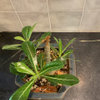Adenium socotranum has arrived
parodise
10 years ago
Hi everyone,
thought I'd share my joy at the arrival of my two true socotranums! These are 4-year-old seedlings I received the other day. The plants are from the same batch - yet another confirmation how different they may be...
Is there anything about socotranums I should pay special attention to, do or avoid doing, for that matter?
One thing I know is they are very slow growers. What has your experience been with them?
Lena



parodiseOriginal Author
greenclaws UK, Zone 8a
Related Professionals
Clemson Landscape Architects & Landscape Designers · Kyle Landscape Architects & Landscape Designers · Clermont Landscape Contractors · Americus Landscape Contractors · Belvedere Park Landscape Contractors · Cincinnati Landscape Contractors · Downey Landscape Contractors · Essex Landscape Contractors · Fort Hunt Landscape Contractors · Fort Myers Landscape Contractors · North Chicago Landscape Contractors · North Potomac Landscape Contractors · Royal Oak Landscape Contractors · Sun City Center Landscape Contractors · Welby Landscape Contractorsrcharles_gw (Canada)
teyo
pachypode
parodiseOriginal Author
parodiseOriginal Author
parodiseOriginal Author
parodiseOriginal Author
parodiseOriginal Author
teyo
parodiseOriginal Author
teyo
greenclaws UK, Zone 8a
greenclaws UK, Zone 8a
pachypode
greenclaws UK, Zone 8a
11otis
tolip
parodiseOriginal Author
parodiseOriginal Author
parodiseOriginal Author
parodiseOriginal Author
tolip
parodiseOriginal Author
pachypode
parodiseOriginal Author
parodiseOriginal Author
rcharles_gw (Canada)
pachypode
parodiseOriginal Author
parodiseOriginal Author
parodiseOriginal Author
rcharles_gw (Canada)
parodiseOriginal Author
rcharles_gw (Canada)
parodiseOriginal Author
parodiseOriginal Author
rcharles_gw (Canada)